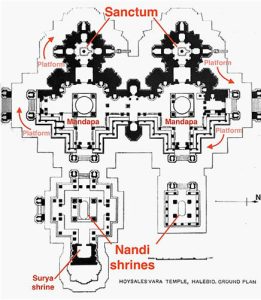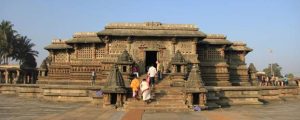Subject: GS-1 Arts and Culture
Context:
- The Sacred ensembles of the Hoysala, which includes three temples (temples of Halebid, Belur, and Somanathapura) in Karnataka, will be India’s 42nd UNESCO World Heritage Site.
- Sacred Ensembles of the Hoysala have been on UNESCO’s Tentative list since April 2014.
- On 17 September 2023, Rabindranath Tagore’s Santiniketan, the university town in West Bengal, was also included as India’s 41st world heritage site.
About Hoysala Architecture:
- The Hoysala temples in Hassan district, Karnataka, are architectural masterpieces built in the 12th-13th centuries.
- They attest to the creativity and skill of the Hoysala artists and architects.
- The Hoysala temples have a basic Dravidian form but show strong influences of the Bhumija, Nagara, and Karnataka Dravida styles.
- The Hoysala temples are known for their intricate carvings, geometric pillars, and star-shaped ceilings.
- Hoysala temples are also known for their beautiful sculptures of deities, animals, and mythical creatures.
- The Hoysala used soft soapstone for their structures as they were found suitable for intricate carvings.

Key Architectural Elements of Hoysala temples:
- Mantapa: Hall where people gather during prayers. Usually divided into open outer mantapa and closed inner mantapa.
- Outer mantapa has perforated stone screens (jali) that allow light and air to pass through.
- Inner mantapa is smaller and has four lathe-turned pillars to support the ceiling.
- Vimana: Shrine that houses the image of the presiding deity. Often topped by a tower that is either stellate (“star-shaped”) or shaped as a staggered square. Tower is profusely decorated with sculptures of Hindu deities, animals, and mythical creatures.
- Sculptures: Depict a variety of subjects, including Hindu deities, animals, mythical creatures, and scenes from the Hindu epics. Often carved in soapstone, which is a soft and easy-to-carve material. Other notable architectural elements:
- Lathe-turned pillars, Star-shaped ceilings and Perforated stone screens (jali) are other key features.
|
Hoysaleswara Temple (Halebid)
-
- Location of Hoysala temples: Banks of Dwarasamudra tank in Halebid, Karnataka
- Built-in: In the 12th century, the temple was built by Ketamalla, during the rule of King Vishnuvardhana of the Hoysala Empire.
-
- One of the largest temples dedicated to Lord Shiva in South India
- Garuda Pillars: Another interesting object in the temple complex is the rare Garuda Sthamba.
The Chennakeshava temple:
-
- Location: the main temple in the complex at Belur (Hassan district),
- Built-in: It was constructed by King Vishnuvardhana in the 12th century to commemorate his victory over the Cholas.
-
- There are more than 80 Madanika sculptures in the temple, dancing, hunting, and standing under canopies of trees.
- The Garbhagriha is stellar in shape and its zigzag walls make the figures of 24 forms of Vishnu look different at different times of the day due to light.

The Keshava Temple:
-
- Location: Somanathapura village (Mysore district).
- Built-in: It was built in A.D 1268, by Somanatha a Dandanayaka under the Hoysala king Narashima III.
-
- It has 3 sanctums on the West, South and North to Keshava, Venugopala and Janardhana, all connected.
- The temple itself occupies the middle of the rectangular courtyard surrounded by 64 cells each with pillars in front, forming an appropriate cloistered setting.

Owing to its combination of 3 shrines, the temple plan is in the shape of a cross, with its sole entrance on the east.
The UNESCO’s World Heritage Committee:
-
- The Committee is responsible for the implementation of the World Heritage Convention, defines the use of the World Heritage Fund and allocates financial assistance upon requests from States Parties.
- It meets once a year, and consists of representatives from 21 of the States Parties to the Convention elected by their General Assembly.
- At its first session, the Committee adopted its Rules of Procedure of the World Heritage Committee.
- Functions:
-
- It has the final say on whether a property is inscribed on the World Heritage List.
- It examines reports on the state of conservation of inscribed properties and asks States Parties to take action when properties are not being properly managed.
- It also decides on the inscription or deletion of properties on the List of World Heritage in Danger.
|
Source: PIB
![]() 19 Sep 2023
19 Sep 2023

